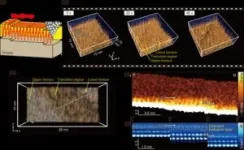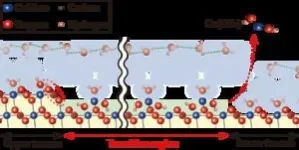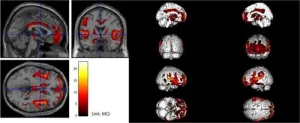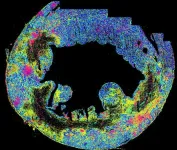Researchers at Nano Life Science Institute (WPI-NanoLSI), Kanazawa University, implement modifications to their high-speed atomic force microscopy that simultaneously improve resolution and speed, while enabling direct measurements of 3D structures to provide conclusive evidence of a contested hydration layer forming as calcite dissolves.
Understanding the dissolution processes of minerals can provide key insights into geochemical processes. Attempts to explain some of the observations during the dissolution of calcite (CaCO3) have led to the hypothesis that a hydration layer forms, although this has been contested. Hydration layers are also important as they play a role in a number of processes including adhesion, corrosion and wetting, as well as the folding, stability and recognition of proteins. Now researchers led by Kazuki Miyata, Adam S. Foster and Takeshi Fukuma at the Nano Life Science Institute (WPI-Nano LSI) at Kanazawa University in Japan have successfully upgraded their atomic force microscope to retrieve imaging data with the time and spatial resolution needed to obtain 3D structure images that provide direct evidence of a hydration layer forming during the dissolution of calcite.
The hypothesis of a hydration layer forming during the dissolution of calcite was prompted by simulations of the process, which pointed to the production of a Ca(OH)2 layer across “transition regions” as calcite dissolves. Despite being unstable in the bulk or on flat terraces, Ca(OH)2 can appropriate some stability from step edge structures, although the mechanism behind this is not well understood. This could explain the stability of the Ca(OH)2 next to the step edges but since the transition regions observed in experiments span several nanometres, the authors had posited the possibility that the Ca(OH)2 acquires its stability through indirect interactions with the step by means of a hydration structure. However, as the researchers point out in their report, hydration effects remain “poorly understood” as techniques for imaging changes in solid–liquid interfacial structures are lacking.
Atomic force microscopy (AFM) obtains high resolution images by using a nanoscale cantilever to feel the surface a little like the needle of a record player feels out the grooves in vinyl. However, despite a huge step change in the rate of image acquisition that can be achieved with the invention of high-speed (HS) AFM, AFM has still suffered a little from a trade-off between speed and spatial resolution. Efforts to apply it to study dissolution processes is also hampered because the tool is designed to scan the topologies and interactions across 2D surfaces, and dissolution of minerals involves 3D structural changes.
Previous work had expedited the higher resolution “frequency modulated” (FM) AFM so that the image acquisition time was reduced from a minute to just 0.5 s/frame. This upgrade allowed the authors to image the transition region from which they inferred the presence of a hydration layer, but some extrapolation was required to extract 3D structure information from comparison of the 2D-AFM data to 3D simulation, leaving some to doubt the conclusions. Modifications of AFM to extract 3D force data using AFM have previously been demonstrated, although once again despite some improvements to speed things up, to around 1 minute/frame the image acquisition time remained prohibitive for observing dynamic processes.
The authors get around all these drawbacks by combining the HS-FM-AFM with 3D-SFM. This involved increasing the bandwidth of their 3D-SFM while maintaining a force resolution of 10-100nN, fast synchronization of the signals in the lateral scanning and 3rd dimension, and fast recording of the cantilever frequency shifts. With these in place the researchers were able to capture 3D-SFM images in just 1.6 s/frame. They used the approach to image the dissolution of calcite.
“The HS-3D-SFM images produced in the present work clearly show the 3D distribution predicted by the simulations, thus supporting the existence of an extended hydration layer,” they point out in their report.
Glossary
AFM
Atomic force microscopy was first established in the mid 1980s by Gerd Binnig, Calvin Quate and Christophe Gerber. It uses a nanoscale cantilever with a nanoscale tip attached to it, such that interactions between the tip and the surface result in a deflection of the tip. Thanks to the atomically sharp end of the tip sub nanometre resolution can be achieved.
Frequency modulated AFM
The first demonstration of AFM achieved a lateral resolution of 30 Å in air. A number of modifications to the initial set up helped to improve the device. By avoiding contact with the sample, the approach could be used to study delicate and soft materials. Tapping mode or frequency modulated AFM helped to improve the sensitivity of the device for certain set ups. Here the end of the cantilever flaps up and down and the change in frequency due to the interactions with the surface is monitored.
High-speed AFM
In 2008 Toshio Ando at Kanazawa University demonstrated how modifications that improve the feedback bandwidth and phase detection as well as optimizations to the cantilever could speed up the image acquisition rate sufficiently to allow AFM movies of dynamic processes.
AFM is better suited to imaging biological samples than the scanning tunnelling microscope that had been developed before it because it does not require a conducting sample. The development of HS-AFM allowed people to use the technique to visualise molecular processes for the first time.
Later developments helped people to speed up FM-AFM to capture images at a rate of 0.5 s/frame too. The NanoLSI researchers used this approach to study the dissolution of calcite previously but they could only monitor the 2D structure change. To draw conclusions on the 3D shape they assumed the presence of the Ca(OH)2, calculated the 3D structure with the Ca(OH)2 layer and a hydration layer on top, infer the forces from that, and hence the frequency changes an AFM would measure and the resulting 2D height map, and finally compare that with the image obtained from 2D-FM-AFM.
3D-AFM
Further developments of 3D-AFM made it capable of monitoring the forces acting on the tip in all three dimensions. Although originally quite slow because of the complexity of the tip motions involved, the NanoLSI researchers found they could speed it up by modulating the vertical height of the tip sinusoidally while scanning laterally.
This “3D scanning force microscopy (3D-SFM)” allowed images to be captured at a rate of 1 minute/frame – fast enough to avoid image distortion due to tip drift but not yet fast enough to monitor dynamic processes, which was enabled by combining 3D-AFM with HS-FM-AFM. This allowed direct monitoring of dynamic 3D structure changes.
Funding
This work was supported by World Premier International Research Center Initiative (WPI), MEXT, Japan; JSPS KAKENHI grant numbers JP16H02111, JP20H00345, JP20H05212, JP21H05251 and JP22H01954; JST PRESTO Grant Number JPMJPR23JC. K. Miyata was supported by the Mitani Foundation for Research and Development; Advanced Technology Institute Research Grants. Computing resources from the Aalto Science-IT project and CSC, Helsinki are gratefully acknowledged. A.S.F. was supported by the Academy of Finland (project no. 314862).
About Nano Life Science Institute (WPI-NanoLSI), Kanazawa University
Understanding nanoscale mechanisms of life phenomena by exploring “uncharted nano-realms”
Cells are the basic units of almost all life forms. We are developing nanoprobe technologies that allow direct imaging, analysis, and manipulation of the behavior and dynamics of important macromolecules in living organisms, such as proteins and nucleic acids, at the surface and interior of cells. We aim at acquiring a fundamental understanding of the various life phenomena at the nanoscale.
https://nanolsi.kanazawa-u.ac.jp/en/
About the World Premier International Research Center Initiative (WPI)
The WPI program was launched in 2007 by Japan's Ministry of Education, Culture, Sports, Science and Technology (MEXT) to foster globally visible research centers boasting the highest standards and outstanding research environments. Numbering more than a dozen and operating at institutions throughout the country, these centers are given a high degree of autonomy, allowing them to engage in innovative modes of management and research. The program is administered by the Japan Society for the Promotion of Science (JSPS).
See the latest research news from the centers at the WPI News Portal: https://www.eurekalert.org/newsportal/WPI
Main WPI program site:
www.jsps.go.jp/english/e-toplevel
About Kanazawa University
As the leading comprehensive university on the Sea of Japan coast, Kanazawa University has contributed greatly to higher education and academic research in Japan since it was founded in 1949. The University has three colleges and 17 schools offering courses in subjects that include medicine, computer engineering, and humanities.
The University is located on the coast of the Sea of Japan in Kanazawa – a city rich in history and culture. The city of Kanazawa has a highly respected intellectual profile since the time of the fiefdom (1598-1867). Kanazawa University is divided into two main campuses: Kakuma and Takaramachi for its approximately 10,200 students including 600 from overseas.
http://www.kanazawa-u.ac.jp/en/
END
Atomic force microscopy upgrade captures 3D images of calcite dissolving
2024-08-29
(Press-News.org)
ELSE PRESS RELEASES FROM THIS DATE:
New research unveils cellular pathways to Alzheimer’s and alternative brain aging
2024-08-29
A new study has found an answer for a long-lasting question in aging research - Is Alzheimer’s disease-dementia a form of accelerated aging or is there a different path that can lead us to healthier brain aging? In an international effort, the researchers mapped 1.65 million cells from 437 aging brains, and uncovered distinct paths of cellular change in the aging brains, with one leading to Alzheimer’s disease and the other to an alternative form brain aging. They also point to specific cell signatures predicted to advance disease once they appear in the aging ...
JMIR Medical Informatics is inviting submissions for a new theme issue titled: "Advancing Digital Health: Real-World Implementation and Strategic Insights from Industry-Driven Innovation"
2024-08-29
Toronto- August 27, 2024 - JMIR Publications invites submissions to a new theme issue titled “Advancing Digital Health: Real-World Implementation and Strategic Insights from Industry-Driven Innovation” in JMIR Medical Informatics, a leading peer-reviewed journal indexed in PubMed with a unique focus on clinical informatics and the digitization of care processes.
The health care landscape is transforming rapidly, driven by technological innovation and the pressing need for more efficient, accessible and patient-centric health care solutions.
Yet, the health IT industry grapples with ...
Terasaki Institute scientist awarded 2024 NARSAD Young Investigator Grant
2024-08-29
LOS ANGELES, August 29, 2024 — Yangzhi Zhu, Ph.D., Assistant Professor at the Terasaki Institute for Biomedical Innovation (TIBI), has been awarded the prestigious 2024 NARSAD Young Investigator Grant for his groundbreaking work on a lab-on-a-contact lens (LoCL) system. This innovative technology is designed to monitor mental health by providing real-time, non-invasive tracking of panels of key biomarkers, from the wearer’s tears.
Mental health disorders, such as anxiety and depression, affect nearly a billion ...
A breakthrough in diagnosing hydrocephalus: Multimodality approaches enhance accuracy and reduce costs
2024-08-29
A recent case report published in Cyborg Bionic Systems details the diagnosis of Idiopathic Normal Pressure Hydrocephalus (iNPH) using multimodality diagnostic approaches, highlighting significant advancements in medical diagnostics and patient care. The study conducted by a team of researchers from Tianjin Medical University General Hospital, Tianjin, China, presents a comprehensive case study of a 68-year-old male patient diagnosed with iNPH, showcasing the effectiveness of these advanced diagnostic techniques.
iNPH is a condition characterized by the accumulation of cerebrospinal fluid (CSF) causing ventricular dilation, ...
This tiny backyard bug does the fastest backflips on earth
2024-08-29
Move over, Sonic. There’s a new spin-jumping champion in town – the globular springtail (Dicyrtomina minuta). This diminutive hexapod backflips into the air, spinning to over 60 times its body height in the blink of an eye, and a new study features the first in-depth look at its jumping prowess.
Globular springtails are tiny, usually only a couple millimeters in body length. They don’t fly, bite or sting. But they can jump. In fact, jumping is their go-to (and only) plan for avoiding predators. And they excel at it – to the naked eye it seems as though they vanish entirely when they take off.
“When globular springtails ...
Climate change increases foodborne illness risk from raw produce
2024-08-29
Highlights:
Salmonella enterica causes disease in 1.2 million people in the U.S. annually.
The most common way people get infected is by consuming contaminated fresh produce.
New research shows that bacterial leaf spot of lettuce and high humidity promote S. enterica growth in lettuce, and climate change is predicted to increase humid periods.
Washington, D.C.—Climate change will increase the risk of the foodborne illness from Salmonella enterica, according to a new study. The research was published today in Applied and Environmental Microbiology, a journal of the American Society for Microbiology.
S. enterica causes disease in 1.2 million people in the ...
NSF Grant empowers FAU to explore Caribbean climate crisis with ethnography
2024-08-29
Transformations in the global climate system are profoundly destabilizing ecosystems across the Caribbean, with South Florida and Puerto Rico experiencing notable impacts. To address this challenge, researchers from Florida Atlantic University and the University of Puerto Rico (UPR) in Cayey, are turning to ethnography – an in-depth, immersive research method that involves observing and interviewing people in their natural settings.
FAU’s Dorothy F. Schmidt College of Arts and Letters, in collaboration with UPR Cayey, has received a $650,000 grant from ...
A bacterial defense with potential application in genome editing
2024-08-29
COLUMBUS, Ohio – Scientists who have described in a new study the step-by-step details of a bacterial defense strategy see the mechanism as a promising platform for development of a new genome-editing method.
The system involves two proteins that team up to disable plasmids, small DNA molecules that exchange genetic information among different bacterial strains. While plasmids provide evolutionary benefits, they can also be seen by host bacteria as threats.
The research team determined that one protein uses a short piece of DNA – known as a DNA guide – to ...
Labor day crowds temporarily impact local streams, research shows
2024-08-29
Crowds flocking to rivers and streams over Labor Day weekend are doing more than cooling off and having fun. They’re temporarily introducing chemicals and microscopic organisms into their local waterways, according to new research from Johns Hopkins University.
The research, published today in ACS ES&T Water, is the first holistic assessment of how recreation impacts streams. Findings also provide insight into the compounds and chemicals people are splashing around in when their favorite swimming spots are packed.
“Residue from ...
Borderzone Breakthrough: A new source of cardiac inflammation
2024-08-29
Ischemic heart disease is the most common cause of death in the world. It begins with a “heart attack”, also known as a myocardial infarction (MI), which causes part of the heart to die due to inadequate coronary blood flow. This leads to vigorous inflammation, heart wall remodeling, and heart failure.
Anti-inflammatory drugs have been surprisingly ineffective at preventing heart failure. As a consequence, they are not a routine part of post-MI care. However, it is possible that the most potent molecular and cellular inflammation targets have yet to be discovered.
In the Aug. 28, ...








